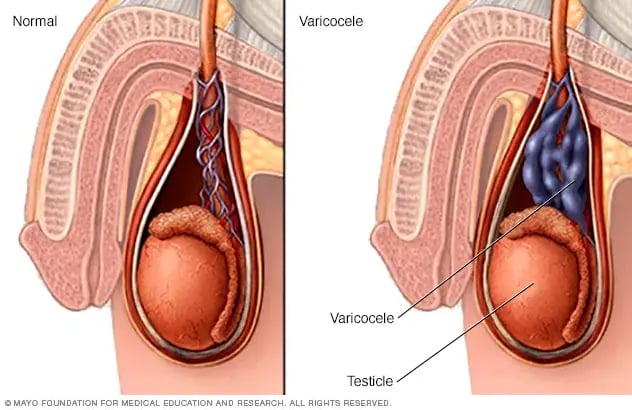Swelling of the testicles and scrotum is never a good sign. For most men, the best thing you can do is make an appointment with your doctor to have things checked out.
But since you’re looking for information online, we’ll cover two potential causes of testicular swelling - varicoceles and hydroceles - and look at the similarities and differences in symptoms, causes and treatment options.
What is a Varicocele?
A varicocele is a collection of swollen veins in the scrotum. Issues with blood flow can cause a build up, usually on the left side, and can lead to a varicocele developing.

What is a Hydrocele?
A hydrocele is a lump in the scrotum caused by an excess of fluid around the testicles. It causes swelling when fluid builds up in the thin sheath surrounding the testicle.

They are usually found in newborns and most disappear without treatment before the age of 1.
Some older boys and men can develop a hydrocele due to inflammation caused by an injury to the scrotum.
Hydroceles are usually not painful or harmful.
There are two types of hydroceles, communicating and non-communicating. Communicating hydrocele has contact with fluids of the abdominal cavity. This is due to the failure of the processus vaginalis (thin membrane extends through the inguinal canal and extends to the scrotum) and can increase the risk for both a hernia and hydrocele to develop.
A non-communicating hydrocele is where the inguinal cord closes but there is still extra fluid around the testicle in the scrotum.
Symptoms of a Varicocele
Symptoms of a varicocele can include:
- A Dull Ache in the Testicles
- A Feeling of Heaviness in the Testicles
- Visibly Swollen Veins
- Visibly Smaller Testicle
You may have also heard the term ‘bag of worms’ and this describes what varicoceles can look and feel like, and is another telltale sign of varicoceles.
Symptoms of a Hydrocele
The typical symptoms may include painless swelling of one or both testicles, experiencing discomfort from the heaviness of a swollen scrotum, and worsening swelling in the morning than in the evening.
Causes of Varicocele
Varicoceles occur because of a problem with the valves in the veins which carry blood from the scrotum and testicles.
A spermatic cord, within the pampiniform plexus, holds up each testicle, and this cord contains the veins, arteries, and nerves that support the testicles. In healthy veins, one-way valves move the blood from the testicles back to the heart.
When "leaky", these valves do not return the blood back to the heart as they should and this causes a buildup of pressure, and therefore swollen veins, and a varicocele develops slowly over time. They are more common on the left side of the scrotum as the left testicular vein is more prone to valve problems.
Causes of a Hydrocele
A hydrocele can develop before birth. During development, the baby’s testicles descend from the abdominal cavity and into the scrotum. Each testicle is accompanied by a sac containing fluid that surrounds the testicles. Under normal circumstances, each sac closes and the fluid is absorbed.
However, sometimes the fluid can remain after the sac closes, causing a non-communicating hydrocele, but is usually absorbed during the first year of life. In other cases the sac remains open and causes a communicating hydrocele
A hydrocele can develop as a result of injury or inflammation within the scrotum. Inflammation might be caused by an infection in the testicle or in the small, coiled tube at the back of each testicle (epididymitis).
Diagnosis of a Varicocele
You can check for a varicocele yourself by performing a physical examination, paying attention to swollen veins which have been described as feeling like a 'bag of worms'. If you feel something you think is abnormal, you can then make an appointment with your GP.
Diagnosing a varicocele is usually done via a physical examination by your GP or a specialist, such as an Interventional Radiologist or Urologist.
In some cases, your doctor may perform a scrotal ultrasound, which can help measure the spermatic veins and gives a more detailed, accurate, visual depiction of the condition.
Diagnosis of a Hydrocele
Much like a varicocele, your doctor will start with a physical examination to check for swelling and tenderness. They may apply pressure to the stomach and abdomen and might shine a light through the scrotum to see if fluid is building up.
After that, your doctor might recommend a blood or urine test to check for infection, and may even perform an ultrasound to rule out other conditions such as a hernia or tumour.
Treating a Varicocele
One treatment option, and the one that we offer at Northern Beaches Interventional Radiology, is varicocele embolisation. Varicocele embolisation is the process of blocking blood vessels in the testicles that have caused a varicocele to develop.
A thin tube is introduced via a vein in the neck or groin and navigated to the veins inside the abdomen under x-ray guidance. Once in position special metal coils, and sometimes foam, are used to close the abnormal veins.
Treating a Hydrocele
In babies hydroceles usually go away on their own. For men it’s important to speak with a doctor as the swelling can be associated with an underlying condition.
A hydrocele that doesn’t go away on it’s own might need surgical intervention, typically a hydrocelectomy done under general or local anesthesia.
Now You Know the Difference
Two similar conditions, both affecting men and both in the testicles, but both with different causes, symptoms and treatments. Like all health conditions, arming yourself with the right knowledge is the first step in understanding when is the right time to seek expert advice.




